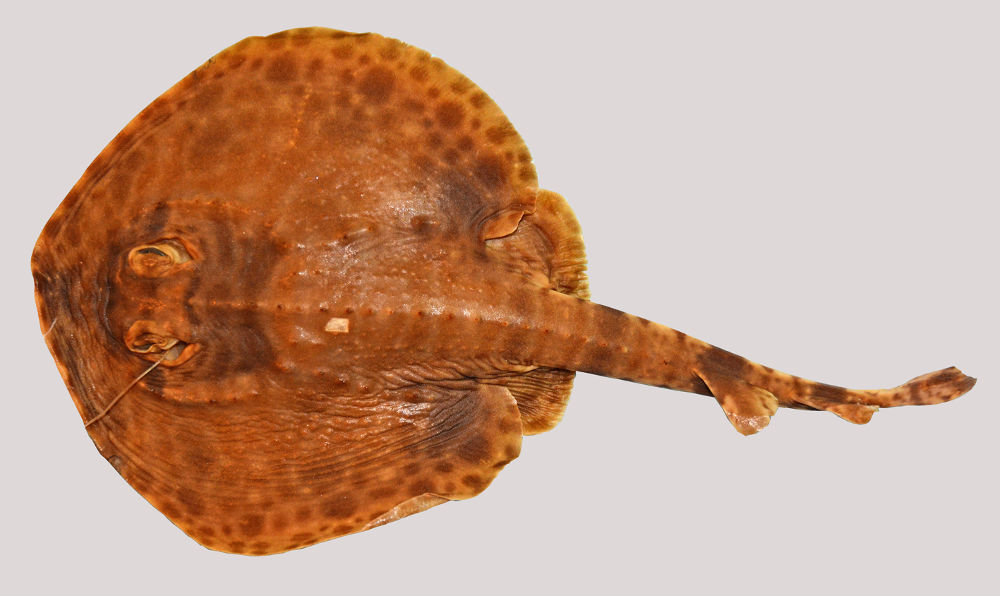Zanobatus maculatus
Séret, 2016
Classification: Elasmobranchii Rhinopristiformes Zanobatidae
Reference of the original description
Zanobatus maculatus, a new species of panray from the Gulf of Guinea, eastern central Atlantic (Elasmobranchii: Batoidea: Zanobatidae). Zootaxa, 4161(4), 509–522
Zanobatus maculatus, a new species of panray from the Gulf of Guinea, eastern central Atlantic (Elasmobranchii: Batoidea: Zanobatidae). Zootaxa, 4161(4), 509–522
Types
Zanobatus maculatus
Holotype: MNHN: 1990-467; Paratype: MNHN: 1967-735; MNHN: 1989-1291; MNHN: 1989-1292; MNHN: 1989-1293; MNHN: 1989-1519; MNHN: 1989-1525; MNHN: 1989-1537; MNHN: 1989-1524; MNHN: 2015-63; MNHN: 2015-64;
Zanobatus maculatus
Holotype: MNHN: 1990-467; Paratype: MNHN: 1967-735; MNHN: 1989-1291; MNHN: 1989-1292; MNHN: 1989-1293; MNHN: 1989-1519; MNHN: 1989-1525; MNHN: 1989-1537; MNHN: 1989-1524; MNHN: 2015-63; MNHN: 2015-64;
Description :
Citation: Zanobatus maculatus Séret, 2016: In: Database of modern sharks, rays and chimaeras, www.shark-references.com, World Wide Web electronic publication, Version 12/2025
Please send your images of "Zanobatus maculatus" to info@shark-references.com

Zanobatus maculatus Séret, 2016, holotype, MNHN 1990-467, male 302 mm TL, dorsal view © Bernhard Serét, France

Zanobatus maculatus Séret, 2016, holotype, MNHN 1990-467, male 302 mm TL, dorsal view © Bernhard Serét, France
Common names
 Raie maculée,
Raie maculée,  Maculate Panray
Maculate Panray
 Raie maculée,
Raie maculée,  Maculate Panray
Maculate Panray
Short Description
Original diagnosis after SERÉT, 2016 [24416]: The new species is distinguished from its unique congener Zanobatus schoenleinii by the following set of characters: dorsal surface of disc brownish to reddish brown, with numerous dark brown blotches, sometimes surrounded by a network of whitish dots; ventral surface of disc pale creamy white or orange-brown, with conspicuous dark brown posterolateral margins; crown of dermal denticles of dorsal surface spearhead-shaped; enlarged thorny denticles of the dorsal surface more numerous and stronger, in parallel rows on trunk and in concentric semi-circular rows on pectoral fins; 54–64 tooth rows in upper jaw; 36–44 (mode 39) predorsal vertebrae; maximum size 359 mm TL.
Original diagnosis after SERÉT, 2016 [24416]: The new species is distinguished from its unique congener Zanobatus schoenleinii by the following set of characters: dorsal surface of disc brownish to reddish brown, with numerous dark brown blotches, sometimes surrounded by a network of whitish dots; ventral surface of disc pale creamy white or orange-brown, with conspicuous dark brown posterolateral margins; crown of dermal denticles of dorsal surface spearhead-shaped; enlarged thorny denticles of the dorsal surface more numerous and stronger, in parallel rows on trunk and in concentric semi-circular rows on pectoral fins; 54–64 tooth rows in upper jaw; 36–44 (mode 39) predorsal vertebrae; maximum size 359 mm TL.
Distribution
Gulf of Guinea, from Ivory Coast to Gabon, with two records from Angola [24416] Source: www.gbif.org
Gulf of Guinea, from Ivory Coast to Gabon, with two records from Angola [24416] Source: www.gbif.org
Dentition
Teeth small, in quincunx, forming a pavement of 54–64 rows (mean 59, n=11) in the upper jaw; teeth similar on both jaws; crown diamond-shaped with rounded margins and blunt cusps; cusps slightly more acute in mature males. [24416]
Teeth small, in quincunx, forming a pavement of 54–64 rows (mean 59, n=11) in the upper jaw; teeth similar on both jaws; crown diamond-shaped with rounded margins and blunt cusps; cusps slightly more acute in mature males. [24416]
Remarks
shark-references Species-ID=14694;
shark-references Species-ID=14694;

















